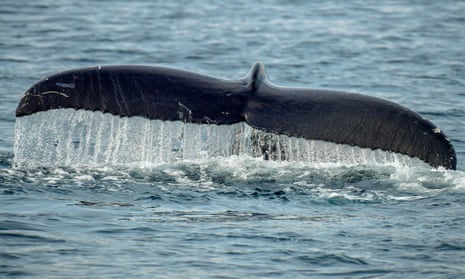Residents of the New South Wales coastal town of Port Macquarie are fighting to have the body of a whale exhumed from a local beach because of fears that oils from the animal’s carcass are attracting sharks to the area.
The body of a 12-metre, 20-tonne humpback whale that washed up on a Nobbys Beach on Sunday was buried there by local authorities as “an option of last resort” after strong winds and a retreating tide prevented them from towing it back out to sea.
The whale had dragged a fishing trap more than 1,700 kilometres from Tasmania before it became beached.
But the decision to bury the whale outraged residents in the town, who fear that leachate from the animal will find its way into the water and attract sharks. The belief that whale burials are linked to shark sightings is popular among surfers but has never been tested.
Port Macquarie: A buried rotting whale carcass has attracted a swarm of great white sharks to Nobbys Beach. https://t.co/tcCDRRDEgf #7News pic.twitter.com/O34sCMhnNn
— 7 News Sydney (@7NewsSydney) September 21, 2017
Beaches in the town have been closed since the animal was buried and the New South Wales Department of Industry said there had been between one and four sharks detected at Port Macquarie since Sunday.
On Wednesday night the owner of a local surf school, Corey Enfield, presented a petition to the local council signed by more than 3,000 people calling for the whale to be dug up.
The shark was buried at a beach not traditionally used for swimming, which is about 500 metres from a popular surf beach where Enfield operates.
A popular beach holiday destination, he said Port Macquarie residents had been “dumbfounded” by the decision.
“I don’t want to use the word anger but I was very frustrated, I felt like my business was being threatened,” he said.
But there may be a silver lining. After Wednesday’s meeting the council issued a statement confirming that it would investigate options to dig up the animal.
“We know an operation to recover the 20-tonne whale carcass from a geographically inaccessible beach and dispose of it in another location is going to be a significant challenge but we recognise the need to address the community’s concerns,” said Craig Swift McNair, general manager of Port Macquarie-Hastings Council.
There are still no details about what the council will do with the whale once it has been exhumed.
Last year Prof Isaac Santos from Southern Cross University received funding from the NSW government to begin a three-year study figuring out whether sharks are attracted to whale burial sites.
“We often have members of the community making claims that whales buried in the sand attract sharks to the surf but there is no scientific information to back that up,” Santos said. “We really have no idea whether the whales on the beach attract sharks and we’re trying to figure out what is happening there.”
Santos and his team of researchers plan to begin measuring the decomposition plume from whale carcasses and using the size and make-up of the plume to determine the level of pollution associated with it.
“We are looking at pollution from carcasses in the form of nutrients and changes in carbon chemistry – basically the oils coming out of the whale and how long they stay in the beach,” he said.
He then plans to use lab experiments to measure how juvenile sharks respond to that same material.
James Tucker, a researcher in Santos’ team, said there were about 10 large whale strandings each year in NSW.
“They are relatively frequent and are increasing as whale the population is increasing,” he said. “It’s important to note that that is actually a really positive sign for whale populations.”
